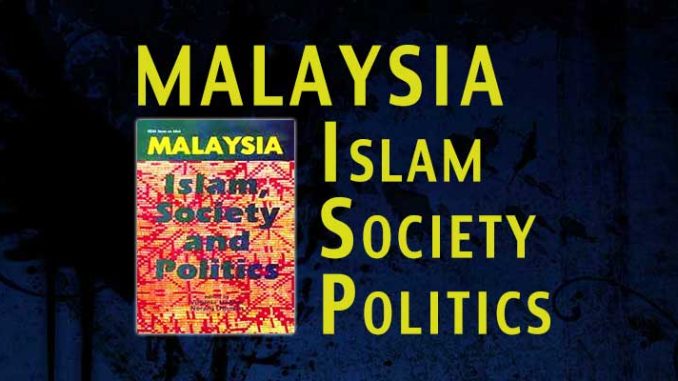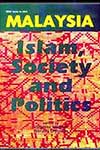
Malaysia: Islam, Society and Politics
Virginia Hooker and Norani Othman, editors
Singapore / ISEAS Series on Islam, Institute of Southeast Asian Studies / 2003
Virginia Hooker sets the tone and form in the first chapter by presenting a thoughtful overview of Malaysian politics since the 1960s – the period during which Kessler initiated his fieldwork among Kelantanese Malays. In “Social Science Approaches to Understanding Religious Practices,” William Roff gives a detailed analysis of the Haj pilgrimage by testing influential theoretical frameworks on ritual, such as Van Gennep’s rite de passage and Turner’s communitas. Since there has been a lack of analysis on this “cryptic phenomena” in terms of ritual performance, one of the chapter’s obvious intentions is to remedy the deficiency. Years ago, when Roff was in a Malay village conducting historical research and learning the language, he observed that pilgrims always returned home changed. Among other things, they displayed transformation in a “variety of obvious and outer, symbolic ways”(49). Such transformation among pilgrims is not unique to the Malays, but can be observed in all Muslim communities. Celebrations preceding and following the pilgrimage may and do vary between localities, sometimes dramatically, but the essence of the Haj – personal transformation – seems to transcend cultural particularities while acting as a bridge between local and global Muslim communities: “[The pilgrims] are graduate members in consequence both of this larger community and of their own national, local, rural, or urban one and, by virtue of having re-enacted the origins of the faith at this front, they are uniquely capable of linking the two and revitalizing in their persons that to which they return” (49). Unfortunately, the author does not give us enough insight into how these processes of linking and revitalizing actually take place and operate once the pilgrims return to their homes. Extremely enlightening in its theoretical application, the chapter’s quasi absence of a proper Malaysian context is a little disappointing, especially for anyone familiar with Roff’s previous writings.
 Kikue Hamayotsu’s chapter efficiently explores the political agencies involved in syariah law reform of the 1980s by using an “actor-oriented, intentionalist approach” (75). In emphasizing the complexity of the reform process, she rightly argues that “societal pressures alone are not sufficient for explaining the level and type of institutionalization of the state religious apparatus” (58). To Hamayotsu, the “incentive structure of the Muslim ruling elite within the UMNO” (58) is more than partly responsible for the reform. The main contention of this chapter is that the institutionalization of the syariah regime reinforces the judicial authority of the state while obliterating the potential for development of an autonomous Islamic legal apparatus. The syariah regime is also discussed by M.B. Hooker, who examines how the syariah court operates in PAS-governed Kelantan. In this chapter, Hooker discusses the Hudud code, the most contested section of the syariah law, at great length. According to the Federal constitution, the state has complete jurisdiction in legal matters, so the Hudud code cannot actually be implemented. However, Hooker convincingly demonstrates that even beyond the constitutional grounds, the Hudud code is “certainly deficient and almost certainly unworkable”(96). Nevertheless, these two chapters suggest that the potential threat emanating from the possibility of full implementation of syariah law, as understood in Malaysia, is directly connected to the fear of PAS being elected at the federal level.
Kikue Hamayotsu’s chapter efficiently explores the political agencies involved in syariah law reform of the 1980s by using an “actor-oriented, intentionalist approach” (75). In emphasizing the complexity of the reform process, she rightly argues that “societal pressures alone are not sufficient for explaining the level and type of institutionalization of the state religious apparatus” (58). To Hamayotsu, the “incentive structure of the Muslim ruling elite within the UMNO” (58) is more than partly responsible for the reform. The main contention of this chapter is that the institutionalization of the syariah regime reinforces the judicial authority of the state while obliterating the potential for development of an autonomous Islamic legal apparatus. The syariah regime is also discussed by M.B. Hooker, who examines how the syariah court operates in PAS-governed Kelantan. In this chapter, Hooker discusses the Hudud code, the most contested section of the syariah law, at great length. According to the Federal constitution, the state has complete jurisdiction in legal matters, so the Hudud code cannot actually be implemented. However, Hooker convincingly demonstrates that even beyond the constitutional grounds, the Hudud code is “certainly deficient and almost certainly unworkable”(96). Nevertheless, these two chapters suggest that the potential threat emanating from the possibility of full implementation of syariah law, as understood in Malaysia, is directly connected to the fear of PAS being elected at the federal level.
Other contributors examine the PAS-UMNO opposition in terms of leadership and discursive strategies. Such is the case with Farish A. Noor, who attempts to explain “the popularity and influence” (199) among ordinary Kelantanese of PAS’ Kelantan leader Tuan Guru Nik Aziz Nik Mat by examining the discursive strategies he uses “to suit the needs and interests of his local audience” (211). The discussion finds some balance with Amrita Malhi’s chapter, which ponders the political strategies deployed by former prime minister Dr. Mahathir and the UMNO-led coalition Barisan National to marginalize PAS as “backward looking” (247), anti-progressive, against modernization, and thus deviating from the “true teaching of Islam.” Malhi’s defense of PAS rhetoric in terms of support for modernization, development, and “sensitivity to grass-root concerns” (255) is not always convincing; nevertheless, it is interesting, engaging, and provocative.
Shamsul A.B. explores the concepts and historical trajectories behind the academic fields of “Malay Studies” and “Malay World Studies.” He also examines the centrality of intellectuals, both Malays and foreigners, in Malay identity formation. His sharp analysis is, without a doubt, applicable to the field of areas studies in general. It is already a well-known fact that the field of area studies was created and shaped by colonial authorities to suit their own needs for categorization and control. Nevertheless, Shamsul’s application of Cohn’s concept of “epistemological space” to the Malay context is theoretically well informed. His argument is that the epistemological space of the Malays was invaded by British colonialists and that Malay studies was essentially shaped through colonial knowledge to serve colonial interests. By examining the “directional changes” experienced by Universiti Kebangsaan Malaysia’s ATMA (Institute of the Malay World and Civilization) over the past thirty years, Shamsul explores the shift from the politically-charged concept of Malay Studies, which continues to exist in its original colonial form, to “the conceptual unity labelled the ‘Malay world’” (115). He describes the “Malay world” as an “abstract, intellectual space as well as a physical location, not unlike the Mediterranean, where a number of civilizations came to meet over time” (116). The question that comes up is: is not this new “epistemological space” also politically oriented? The author does not tackle the question directly, but concludes by saying that this epistemological shift is consistent with “Malaysia’s current standing globally”(119). In this sense, the chapter can be seen to capture some of the important challenges now facing Malaysia’s current leaders, such as the effects of PAS’ attempts to redefine Malay identity according to a more global Islamic frame.
Joel Khan takes up the discourse of Malay exceptionalism, a concept that, in my view, situates Shamsul’s definition of the “Malay world” in an even greater level of complexity. Khan has chosen to “turn away from the political and intellectual elite” (150) by investigating the rapidly growing popularity of single-sex Nasyid bands, a new genre in Malaysian popular music that draws heavily on global Islamic representations. For his research, Khan compares Nasyid bands with the legendary Malay singer-actor P. Ramlee. He finds “certain senses in which Nasyid testifies to a radical change in popular musical styles, and also in the self-perceptions of ordinary Malays” (154). The sudden centrality of Islamic imagery reflects the swift Islamization of Malay popular culture. According to Khan, the “Malaysian others” are as much excluded by Nasyid groups as they were by P. Ramlee. However, his argument goes on to show that the Islamic frame of identity provides more grounds for acknowledging and accepting diversity than the Malay one. Interestingly, the “Malaysian others” are almost completely invisible in the book – with the exception of a few references made by Khan, Hooker, and Mila Stivens – despite the fact that the title does not preclude them. It is worth noting that Khan is the only author who mentions that “Malays are not the only Muslims in Malaysia” (157).
Anthony Milner pursues the topic of Malay identity by addressing the shift in focus from monarchy to race (bangsa) (172). Like Shamsul, Milner locates the development of important aspects of Malay identity in the British colonial era. By examining Malay texts of late nineteenth and early twentieth centuries, he helps us understand that, contrary to what has been stated by other scholars, the survival of the sultanate with its ceremonial structure does not in any sense imply the continuity of the feudal system.
Only one chapter directly addresses questions pertaining to women’s rights. Mila Stivens discusses how activist groups such as Sisters in Islam are attempting to engage the state in a dialogue about women’s positions within the boundaries of complex political, cultural, and religious spaces by developing and deploying local versions of women rights.
This book constitutes an important contribution to studies on Malaysian politics, especially in understanding the prevailing complexity of political and religious articulations in relation to the ideological frameworks of the nation-state’s leaders. Many chapters forefront the tensions existing not just between UMNO and PAS but, more interestingly, between the elite and those at the grass-roots level, between universalism and particularism, and between traditional and modern ways of defining what it really means to be a Malay in Malaysia.
Carole Faucher
Carole Faucher is visiting associate professor at the Tokyo University of Foreign Studies, Research Institute for Languages and Cultures of Asia and Africa.
Kyoto Review of Southeast Asia. Issue 5 (March 2004). Islam in Southeast Asia
